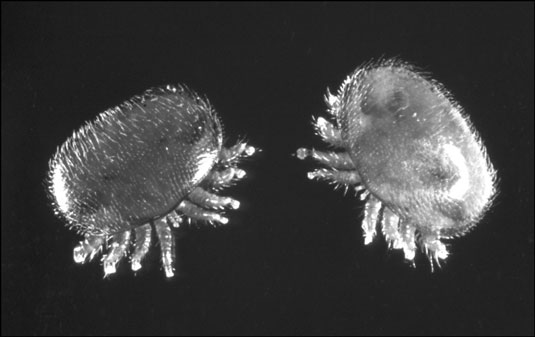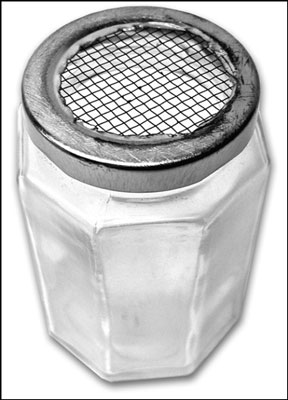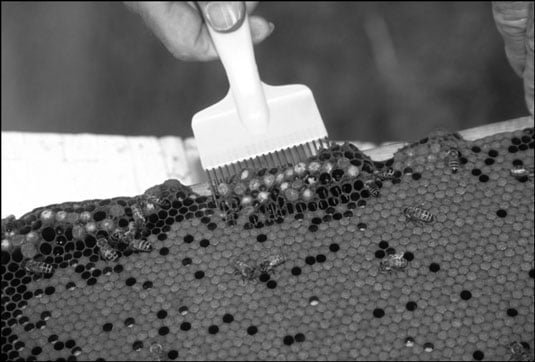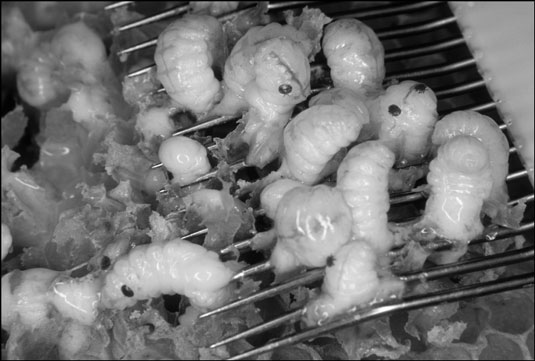Somehow the Varroa mite has made its way from Asia to beehives in all parts of the world, with the exception of Hawaii. Varroa has been in the United States since the late 1980s (maybe longer) and has created quite a problem for beekeepers. Resembling a small tick, this mite is about the size of a pinhead and is visible to the naked eye. Like a tick, the adult female mite attaches herself to a bee and feeds on its blood.
Within the cells Varroa mites feed on the developing bees and lay eggs. They reproduce at a fantastic rate and cause a great deal of stress to the colony. The health of the colony can weaken to a point that bees become highly susceptible to viruses.

Recognizing Varroa mite symptoms
Following is a list of some Varroa mite symptoms. If you suspect a Varroa infestation, confirm your diagnosis using a detection technique.
Do you see brown or reddish spots on the white larvae? You may be seeing mites.
Are any of the newly emerged bees badly deformed? You may notice some bees with stunted abdomens and deformed wings.
Do you actually see Varroa on adult bees? They’re usually found behind the head or nestled between the bee’s abdominal segments.
Did your colony suddenly die in late autumn? You’re way too late to solve the problem this year. You’ll have to start fresh with a new colony next spring.
Using two surefire detection techniques for Varroa
Varroa detection needs to be a routine part of your inspection schedule.
Powdered sugar shake method of mite detection
The powdered sugar shake technique is effective and nondestructive (no bees are killed in the process). You use this process in the early spring (before honey supers go on) and again in the late summer (before the honey supers come off). Follow these steps:
Obtain a one pint wide-mouthed glass jar and modify the lid so that it has a coarse screen insert.
Put 3 to 4 tablespoons of powdered sugar (confectioners’ sugar) into the jar. Alternatively you can use granulated sugar.
Scoop up about half a cup of live bees (about 200 to 300) from the brood nest and place them in the jar. Be careful that you don’t scoop up the queen! Screw on the perforated lid.
Cover the screened lid with one hand (to keep the sugar from spilling out) and shake the jar vigorously.
Shake the sugar through the screened top and onto a white sheet of paper. Open the top and let the bees fly home (you may want to stand to the side as they will be rather unhappy). When the bees have departed, shake the rest of the sugar onto the paper.
Shake authoritatively. Doing so dislodges any mites that are on the bees. The mites can easily be counted, contrasted against the white paper and powdered sugar.

Drone brood inspection method for Varroa mites
Regrettably, the drone brood inspection method kills some of the drone brood. If you choose this drone brood inspection technique, follow these steps:
Find a frame with a large patch of capped drone brood.
Using an uncapping fork, slide the prongs along the cappings spearing the top third of the cappings and impaling the drone pupae as you shovel across the frame.
Pull the drone pupae straight out of their cells.
Any mites are clearly visible against the white pupae. Repeat the process to take a larger sampling.

 Varroa mites first attach themselves to drone pupae, so that’s a good place to look for evidence of an infestation. Can you see the mites on these pupae?
Varroa mites first attach themselves to drone pupae, so that’s a good place to look for evidence of an infestation. Can you see the mites on these pupae?
Evaluating the Varroa population using a screened bottom board
About 10 percent to 15 percent of Varroa mites routinely fall off the bees and drop to the bottom board. But if you use a screened bottom board (sometimes called a “sticky” board), the mites fall through the screen and onto a removable tacky white board.
When this white board is in place, mites fall through the screen and become stuck to the sheet (you apply a thin film of petroleum jelly or a cooking spray to the sheet to help the mites stick).
Just insert the sheet for a day or two and then remove it to count the mites.

